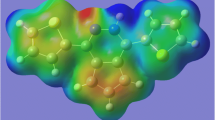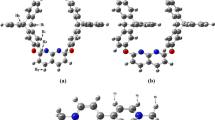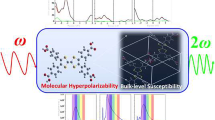Abstract
With the rapid developments of computational methods, now it is effective and efficient to predict properties and underlying reasons at different stages. In this work, we systematically investigated hexachlorocyclotriphosphazene, tris(4–hydroxyphenyl) ethane and their various inorganic–organic hybrid derivatives for dipole moment, polarizability and static first hyperpolarizability. The relation between the nonlinear optical (NLO) properties and the energy gaps were also considered. The geometries of these inorganic–organic hybrid derivatives at different substitution positions have been performed using the B3LYP functional. The ωB97X–D and B3LYP functionals give the high static first hyperpolarizability compared to the CAM–B3LYP and M05–2X levels. Inverse relation has been obtained between the HOMO–LUMO gaps and the hyper-Rayleigh scattering (HRS) first hyperpolarizability \({\beta }_{\text{HRS}}\). This theoretical study reveals underlying changes in the design structures, and shift in properties will provide better understanding and may grab the attention of researchers to study cross-linkable organocyclotriphosphazenes for NLO application.
Graphical abstract







Similar content being viewed by others
References
Qi L, Sehgal A, Castaing JC, Chapel JP, Fresnais J, Fresnais J, Berret JF, Cousin F (2008) Redispersible hybrid nanopowders: Cerium oxide nanoparticle complexes with phosphonated–peg oligomers. ACS Nano 2:879–888. https://doi.org/10.1021/nn700374d
Shephar JJ, Dickie SA, McQuillan AJ (2010) Structure and conformation of methyl–terminated poly(ethylene oxide)–bis[methylenephosphonate] ligands adsorbed to boehmite (ALOOH) from aqueous solutions attenuated total reflection infrared (ATR–IR) spectra and dynamic contact angles. Langmuir 26:4048–4056. https://doi.org/10.1021/la903506q
Tromsdorf UI, Bruns OT, Salmen SC, Beisiegel U, Weller H (2009) A Highly effective, nontoxic T1 MR contrast agent based on ultrasmall PEGylated iron oxide nanoparticles. Nano Lett 9:4434–4440. https://doi.org/10.1021/nl902715v
White MA, Johnson JA, Koberstein JT, Turro NJ (2006) Toward the syntheses of universal ligands for metal oxide surfaces: controlling surface functionality through click chemistry. J Am Chem Soc 128:11356–11357. https://doi.org/10.1021/ja064041s
Boyer C, Bulmus V, Priyanto P, Teoh WY, Amal R, Davis TP (2009) The stabilization and bio–functionalization of iron oxide nanoparticles using heterotelechelic polymers. J Mater Chem 19:111–123. https://doi.org/10.1039/B815202K
Quéffelec C, Petit M, Janvier P, Knight DA, Bujoli B (2012) Surface modification using phosphonic acids and esters. Chem Rev 112:3777–3807. https://doi.org/10.1021/cr2004212
Kamiya T, Hemmi K, Takeno H, Hascimoto M (1980) Studies on phosphonic acid antibiotics. I. Structure and synthesis of 3–(n–acetyl–n–hydroxyamino) propylphosphonic acid (FR–900098) and its n–formyl analogue (FR–31564). Tetrahedron Lett 21:95–98. https://doi.org/10.1016/S0040-4039(00)93633-5
Dake LS, Baer DR, Ferris KF, Friedrich DM (1990) Ligand and structure effects on the N-P bonds of phosphazenes. J Electron Spectrosc 51:439–457. https://doi.org/10.1016/0368-2048(90)80173-8
Allcock HR (1976) Polyphosphazenes: new polymers with inorganic backbone atoms. Science 193:1214–1219. https://doi.org/10.1126/science.193.4259.1214
Allcock HR (1986) Poly(organophosphazenes): synthesis, unique properties, and applications. Makromol Chem Macromol Symp 6:101–108. https://doi.org/10.1002/masy.19860060112
Allcock HR, Dembek AA, Kim C, Devine RLS, Shi Y, Steier WH, Spangler CW (1991) Second–order nonlinear optical poly(organophosphazenes): synthesis and nonlinear optical characterization. Macromolecules 24:1000–1010. https://doi.org/10.1021/ma00005a006
Maturana RG, Valenzuela ML, Schott E, Rojas-Poblete M (2017) Bonding and optical properties of spirocyclic–phosphazene derivatives A DFT approach. Phys Chem Chem Phys 19:31479–31486. https://doi.org/10.1039/C7CP06064E
Jha PC, Krishnan A, Das PK, Ramasesha S (2002) Nonlinear optical properties of linear chain phosphazenes, (PN)x. J Chem Phys 117:2873. https://doi.org/10.1063/1.1491878
Hadji D (2021) Phosphates branching effect on the structure, linear and NLO properties of linear phosphazenes. Mater Chem Phys 262:124280. https://doi.org/10.1016/j.matchemphys.2021.124280
Allcock HR, Primrose AP, Silverberg EN, Visscher KB, Rheingold AL, Guzei IA, Parvez M (2000) Synthesis and Crystal Structure of Tris(9,10–phenanthrenedioxy) cyclotriphosphazene. A new clathration system. Chem Mater 12:2530–2536. https://doi.org/10.1021/cm990381j
Comotti A, Gallazzi MC, Simonutti R, Sozzani P (1998) 13 C and 31 P magic-angle spinning nuclear magnetic resonance spectroscopy of tris(2,3–naphthalenedioxy)cyclotriphosphazene inclusion compounds. Chem Mater 10:3589–3596. https://doi.org/10.1021/cm980338g
Sozzani P, Comotti A, Simonutti R, Meersmann T, Logan JW, Pines A (2000) A porous crystalline molecular solid explored by hyperpolarized xenon. Angew Chem Int Ed 39:2695–2699. https://doi.org/10.1002/1521-3773(20000804)39:15%3c2695::AID-ANIE2695%3e3.0.CO;2-M
Carriedo GA, Alonso FJG, García JL, Carbajo RJ, Ortiz FL (1999) Synthesis and 1H–, 15N–, 31P–, 183W–multinuclear magnetic resonance study of the cyclotriphosphazenes [N3P3(dobp)2(OC5H4N–4)2] and [N3P3(dobp)(OC5H4N–4)4] and their W(CO)5 complexes (dobp = 2,2′–dioxybiphenyl). Eur J Inorg Chem 1999:1015–1020. https://doi.org/10.1002/(SICI)1099-0682(199906)1999:6%3c1015::AID-EJIC1015%3e3.0.CO;2-X
Kuan JF, Lin KF (2004) Synthesis of hexa-allylamino-cyclotriphosphazene as a reactive fire retardant for unsaturated polyesters. J Appl Polym Sci 91:697–702. https://doi.org/10.1002/app.13044
Allcock HR, McDonnell GS, Riding GH, Manners I (1990) Influence of different organic side groups on the thermal behavior of polyphosphazenes: random chain cleavage, depolymerization, and pyrolytic cross–linking. Chem Mater 2:425–432. https://doi.org/10.1021/cm00010a021
Bowmer TN, Haddon RC, ChichesterHicks S, Gomez MA, Marco C, Fatou JG (1991) Effect of substituents on the thermal transitions and degradation behavior of poly[bis(R–phenoxy)phosphazenes]. Macromolecules 24:4827. https://doi.org/10.1021/ma00017a016
Devaraju S, Selvi M, Alagar M (2018) Synthesis and characterization of thermally stable and flame retardant hexakis(4–aminophenoxy)cyclotriphosphazene–based polyimide matrices. Int J Polym Anal Charact 23:29–37. https://doi.org/10.1080/1023666X.2017.1387021
Allcock HR, Siegel LA (1964) Phosphonitrilic compounds. III.1 molecular inclusion compounds of tris(o–phenylenedioxy)phosphonitrile trimer. J Am Chem Soc 86:5140–5144. https://doi.org/10.1021/ja01077a019
Hertzsch T, Budde F, Weber E, Hulliger J (2002) Supramolecular-wire confinement of I2 molecules in channels of the organic zeolite tris(o–phenylenedioxy)cyclotriphosphazene. Angew Chem Int Ed 41:2281–2284. https://doi.org/10.1002/1521-3773(20020703)41:13%3c2281::AID-ANIE2281%3e3.0.CO;2-N
Y. Xia, C. Zhan, J. Qin, D. Liu, B. Wu, C. Chen, Synthesis and SHG effect of some cyclotriphosphazene derivatives, Proc. SPIE 3556, Electro–Optic and Second Harmonic generation materials, devices, and applications II, 3556 (1998) 16–19. https://doi.org/10.1117/12.318233
Zhang L, Shi J, Jiang ZW, Huang MM, Chen ZJ, Gong QH, Cao SK (2008) Photorefractive performance of hyperstructured cyclotriphosphazene molecular glasses containing carbazole moieties. Adv Funct Mater 18:362–368. https://doi.org/10.1002/adfm.200700257
Kim K (2007) Synthesis of nonlinear optical hexakis(4–carboxyphonoxy)cyclotriphosphazene. Polym Korea 04:85–85
Kang L, Zhang X, Liang F, Lin Z, Huang B (2019) Poly(difluorophosphazene) as the first deep–Ultraviolet nonlinear optical polymer: a first–principles prediction. Angew Chem 131:10356–10360. https://doi.org/10.1002/ange.201905025
Allcock HR, Cameron CG, Skloss TW, Taylor-Meyers S, Haw JF (1996) Molecular motion of phosphazene–bound nonlinear optical chromophores. Macromolecules 29:233–238. https://doi.org/10.1021/ma950452+
Ferris KF, Samuels WD, Morita Y, Exarhos GJ (1994) Solution chemistry effects on the nonlinear optical properties of phosphazenes. Mater Res Soc Symp Proc 374:217–223. https://doi.org/10.1557/PROC-374-217
Basharat M, Liu W, Zhang S, Abbas Y, Wu Z, Wu D (2019) Poly(cyclotriphosphazene–co–tris(4–hydroxyphenyl)ethane) microspheres with intrinsic excitation wavelength tunable multicolor photoluminescence. Macromol Chem Phys 220:1900256. https://doi.org/10.1002/macp.201900256
Becke AD (1988) Density–functional exchange–energy approximation with correct asymptotic behavior. J Phys Rev A 38:3098. https://doi.org/10.1103/PhysRevA.38.3098
Lee C, Yang W, Parr RG (1988) Development of the Colle-Salvetti correlation–energy formula into a functional of the electron density. Phys Rev B 37:785–789. https://doi.org/10.1103/PhysRevB.37.785
Yanai T, Tew DP, Handy NC (2004) A new hybrid exchange–correlation functional using the Coulomb–attenuating method (CAM–B3LYP). J Chem Phys Lett 393:51–57. https://doi.org/10.1016/j.cplett.2004.06.011
Iikura H, Tsuneda T, Yanai T, Hirao K (2001) A long–range correction scheme for generalized–gradient–approximation exchange functionals. J Chem Phys 115:3540. https://doi.org/10.1063/1.1383587
Zhao Y, Schultz NE, Truhlar DG (2006) Design of density functionals by combining the method of constraint satisfaction with parametrization for thermochemistry, thermochemical kinetics, and noncovalent interactions. J Chem Theory Comput 2:364. https://doi.org/10.1021/ct0502763
Zhao Y, Truhlar DG (2008) The M06 suite of density functionals for main group thermochemistry, thermochemical kinetics, noncovalent interactions, excited states, and transition elements: two new functionals and systematic testing of four M06–class functionals and 12 other functionals. Theor Chem Acc 120:215. https://doi.org/10.1007/s00214-007-0310-x
Suponitsky KY, Tafur S, Masunov AE (2008) Applicability of hybrid density functional theory methods to calculation of molecular hyperpolarizability. J Chem Phys 129:044109. https://doi.org/10.1063/1.2936121
Suponitsky KY, Masunov AE, Antipin MY (2008) Conformational dependence of the first molecular hyperpolarizability in the computational design of nonlinear optical materials for optical switching. Mendeleev Commun 18:265–267. https://doi.org/10.1016/j.mencom.2008.09.013
Suponitsky KY, Liao Y, Masunov AE (2009) Electronic Hyperpolarizabilities for donor-acceptor molecules with long conjugated bridges: calculations versus experiment. J Phys Chem A 113:10994–11001. https://doi.org/10.1021/jp902293q
Frisch MJ et al (2009) Gaussian09, revision C.01. Gaussian Inc., Wallingford
Castet F, Bogdan E, Plaquet A, Ducasse L, Champagne B, Rodriguez V (2012) Referencemolecules for nonlinear optics: a joint experimental and theoretical investigation. J Chem Phys 136:024506. https://doi.org/10.1063/1.3675848
Bersohn R, Pao YH, Frisch HL (1966) Double quantum light scattering by molecules. J Chem Phys 45:3184. https://doi.org/10.1063/1.1728092
Zheng F, van Sittert CGCE, Lu Q (2017) A computational probe into dissolution inhibitation effect of diazonaphthoquinone photoactive compounds on positive tone photosensitive polyimides. J Phys Chem C 121:1704–1714. https://doi.org/10.1021/acs.jpcc.6b11316
Alam MM, Kundi V, Thankachan PP (2016) Solvent effects on static polarizability, static first hyperpolarizability and one– and two–photon absorption properties of functionalized triply twisted Möbius annulenes: a DFT study. Phys Chem Chem Phys 18:21833–21842. https://doi.org/10.1039/C6CP02732F
Balakina MY, Nefediev SE (2007) The choice of basis set for calculations of linear and nonlinear optical properties of conjugated organic molecules in gas and in dielectric medium by the example of p–nitroaniline. Comput Mater Sci 38:467–472. https://doi.org/10.1016/j.commatsci.2005.05.011
Avci D, Bas A, Lu O, Atalay Y (2011) Effects of different basis sets and donor-acceptor groups on linear and second-order nonlinear optical properties and molecular frontier orbital energies. Int J Quantum Chem 111:130–147. https://doi.org/10.1002/qua.22416
Roy RS, Nandi PK (2015) Exploring bridging effect on first hyperpolarizability. RSC Adv 5:103729–103738. https://doi.org/10.1039/C5RA22615E
Hatua K, Nandi PK (2013) Beryllium–cyclobutadiene multidecker inverse sandwiches: electronic structure and second–hyperpolarizability. J Phys Chem A 117:12581–12589. https://doi.org/10.1021/jp407563f
Hatua K, Nandi PK (2014) Double coned inverse sandwich complexes [M–(η4–C4H4)–M′] of Gr–IA and Gr–IIA Metals: theoretical study of electronic of structure and second hyperpolarizability. J Mol Model 20:2440–2449. https://doi.org/10.1021/j100025a017
Kupka T, Pasterny K, Pasterna G, Brandt K (2008) From planar to nonplanar cyclotriphosphazenes. J Molecul Struct (Theochem) 866:21–26. https://doi.org/10.1016/j.theochem.2008.06.032
Hadji D, Rahmouni A (2016) Molecular structure, linear and nonlinear optical properties of some cyclic phosphazenes: a theoretical investigation. J Mol Struct 1106:343–351. https://doi.org/10.1016/j.molstruc.2015.10.033
Jacquemin D (2005) Linear and nonlinear optics properties of polyphosphazene/polynitrile alternating copolymers. J Chem Theory Comput 1:307–314. https://doi.org/10.1021/ct049884t
Ferris KF, Friedman P, Friedrich DM (1988) Electronic structure of the phosphonitrilic trimer–role of d orbitals in chemical bonding. Int J Quantum Chem 34:207–218. https://doi.org/10.1002/qua.560340824
Craig DP, Paddock NL (1962) 801.Electron distribution in cyclic pπ–dπ systems. J Chem Soc. https://doi.org/10.1039/JR9620004118
Craig DP, Mitchell KAR (1965) 871.“Island” and cyclic delocalisation in pπ–dπ systems. J Chem Soc. https://doi.org/10.1039/JR9650004682
Paddock NL (1964) Phosphonitrilic derivatives and related compounds. Q Rev Chem Soc 18:168–210. https://doi.org/10.1039/QR9641800168
Hadji D, Champagne B (2019) First principles investigation of the polarizability and first hyperpolarizability of anhydride derivatives. Chemistry Africa 2:443–453. https://doi.org/10.1007/s42250-019-00060-3
Hadji D, Rahmouni A, Hammoutène D, Zekri O (2019) First theoretical study of linear and nonlinear optical properties of diphenyl ferrocenyl butene derivatives. J Mol Liq 286:110939. https://doi.org/10.1016/j.molliq.2019.110939
Boukabene M, Brahim H, Hadji D, Guendouzi A (2020) Theoretical study of geometric, optical, nonlinear optical, UV–Vis spectra and phosphorescence properties of iridium(III) complexes based on 5–nitro–2–(2′,4′–difluorophenyl)pyridyl. Theor Chem Acc 139:47. https://doi.org/10.1007/s00214-020-2560-9
Baroudi B, Argoub K, Hadji D, Benkouider AM, Toubal K, Yahiaoui A, Djafri A (2020) Synthesis and DFT calculations of linear and nonlinear optical responses of novel 2–thioxo–3–N, (4–methylphenyl) thiazolidine–4 one. J Sulfur Chem 41:1–16. https://doi.org/10.1080/17415993.2020.1736073
Sim F, Chin S, Dupuis M, Rice J (1993) Electron correlation effects in hyperpolarizabilities of p–nitroaniline. J Phys Chem 97:1158–1163. https://doi.org/10.1021/j100108a010
Pecul M, Pawłowski F, Jørgensen P, Köhn A, Hättig C (2006) High–order correlation effects on dynamic hyperpolarizabilities and their geometric derivatives: a comparison with density functional results. J Chem Phys 124:114101. https://doi.org/10.1063/1.2173253
Zalesny R, Bartkowiak W, Toman P, Leszczynski J (2007) Computational insight into relations between electronic and vibrational polarizabilities within the two–state valence–bond charge–transfer model. J Chem Phys 337:77–80. https://doi.org/10.1016/j.chemphys.2007.06.031
Zalesny R, Wójcik G, Mossakowska I, Bartkowiak W, Avramopoulos A, Papadopoulos MG (2009) Static electronic and vibrational first hyperpolarizability of meta–dinitrobenzene as studied by quantum chemical calculations. J Mol Struct (Theochem) 907:46–50. https://doi.org/10.1016/j.theochem.2009.04.011
Andrea A (2013) Nonlinear optical properties of fluorobenzenes: a time-dependent hartree–fock study. Comput Theor Chem 1013:23–24. https://doi.org/10.1016/j.comptc.2013.03.014
Choi JJ, Kim KM, Lim JS, Lee C, Kim DW (2007) Synthesis and characterization of dendritic nonlinear optical chromophore containing phenylene attached with bulky alkyl group. Macromol Res 15:59–64. https://doi.org/10.1007/BF03218753
Pan Y, Tang X (2008) Synthesis and properties of novel Y–shaped nonlinear optical polymers containing imidazole–based chromophores. J Appl Poly Sci 108:2802–2807. https://doi.org/10.1002/app.27579
Li Z, Qin J, Li S, Ye C, Luo J, Cao Y (2002) Polyphophazene Containing indole-based dual chromophores: synthesis and nonlinear optical characterization. Macromolecules 35:9232–9235. https://doi.org/10.1021/ma020769r
Zoghaib WM, Husband J, Soliman UA, Shaaban IA, Mohamed TA (2013) Analysis of UV and vibrational spectra (FT-IR and FT-Raman) of hexachlorocyclotriphosphazene based on normal coordinate analysis, MP2 and DFT calculations. Spectrochim Acta A Mol Biomol Spectrosc 105:446–455. https://doi.org/10.1016/j.saa.2012.11.071
Basharat M, Abbas Y, Hadji D, Ali Z, Zhang S, Ma H, Wu Z, Liu W (2020) Amorphous covalent inorganic–organic hybrid frameworks (CIOFs) with an aggregation induced selective response to UV–Visible light and their DFT studies. J Mater Chem C 8:13612–13620. https://doi.org/10.1039/D0TC01535K
Hadji D, Rahmouni A (2015) Theoretical study of nonlinear optical properties of some azoic dyes. Med J Chem. 4:185–192. https://doi.org/10.13171/mjc.4.4.2015.15.07.22.50/hadji
Hadji D, Brahim H (2018) Structural, optical and nonlinear optical properties and TD DFT analysis of heteroleptic bis cyclometalated iridium(III) complex containing 2 phenylpyridine and picolinate ligands. Theo Chem Acc 137:180. https://doi.org/10.1007/s00214-018-2396-8
Bensafi T, Hadji D, Yahiaoui A, Argoub K, Hachemaoui A, Kenane A, Baroudi B, Toubal K, Djafri A, Benkouider AM (2021) Synthesis, characterization and DFT calculations of linear and NLO properties of novel (Z)–5–benzylidene–3–N(4–methylphenyl)–2–thioxothiazolidin–4–one. J Sulf Chem 42:645–663. https://doi.org/10.1080/17415993.2021.1951729
Benmohammed A, Hadji D, Guendouzi A, Mouchaal Y, Djafri A, Khelil A (2021) Synthesis, characterization, linear and NLO properties of novel N–(2,4–Dinitrobenzylidene)–3–Chlorobenzenamine schiff base: combined experimental and DFT calculations. J Elec Materi 50:5282–5293. https://doi.org/10.1007/s11664-021-09046-9
Gheribi R, Hadji D, Ghallab R, Medjani M, Benslimane M, Trifa C, Dénès G, Merazig H (2021) Synthesis, spectroscopic characterization, crystal structure, Hirshfeld surface analysis, linear and NLO properties of new hybrid compound based on Tin fluoride oxalate and organic amine molecule (C12N2H9)2[SnF2(C2O4)2]2H2O. J Mol Struct 1248:131392. https://doi.org/10.1016/j.molstruc.2021.131392
Brandão I, Fonseca TL, Georg HC, Castro MA, Pontes RB (2020) Assessing the structure and first hyperpolarizability of Li@B10H14 in solution: a sequential QM/MM study using the ASEC–FEG method. Phys Chem Chem Phys 22:17314–17324. https://doi.org/10.1039/D0CP01268H
Merouane A, Mostefai A, Hadji D, Rahmouni A, Bouchekara M, Ramdani A, Taleb S (2020) Theoretical insights into the static chemical reactivity and NLO properties of some conjugated carbonyl compounds: case of 5–aminopenta–2, 4–dienal derivatives. Monatsh Chem 151:1095–1109. https://doi.org/10.1007/s00706-020-02653-y
Bekki Y, Hadji D, Guendouzi A, Houari B, Elkeurti M (2021) Linear and nonlinear optical properties of anhydride derivatives: a theoretical investigation. Chem Data Collect 37:100809. https://doi.org/10.1016/j.cdc.2021.100809
Muhammad S, AlSehemi AG, Irfan A, Chaudhry AR (2016) Tuning the push–pull configuration for efficient second–order nonlinear optical properties in some chalcone derivatives. J Mol Graph Model 68:95–105. https://doi.org/10.1016/j.jmgm.2016.06.0
Muhammad S, Irfan A, Shkir M, Chaudhry AR, Kalam A, AlFaify S, AlSehemi AG, AlSalami AE, Yahia IS, Xu H-L, Su Z-M (2015) How does hybrid bridging core modification enhance the nonlinear optical properties in donor-π-acceptor configuration? a case study of dinitrophenol derivatives. J Comput Chem 36:118–128. https://doi.org/10.1002/jcc.23777
Author information
Authors and Affiliations
Corresponding author
Ethics declarations
Conflict of interest
The authors declare no conflict of interest.
Additional information
Handling Editor: Andrea de Camargo.
Publisher's Note
Springer Nature remains neutral with regard to jurisdictional claims in published maps and institutional affiliations.
Rights and permissions
About this article
Cite this article
Basharat, M., Hadji, D. Theoretical insights into the nonlinear optical properties of cyclotriphosphazene (P3N3Cl6), tris(4–hydroxyphenyl) ethane and their various inorganic–organic hybrid derivatives. J Mater Sci 57, 6971–6987 (2022). https://doi.org/10.1007/s10853-022-07088-w
Received:
Accepted:
Published:
Issue Date:
DOI: https://doi.org/10.1007/s10853-022-07088-w




